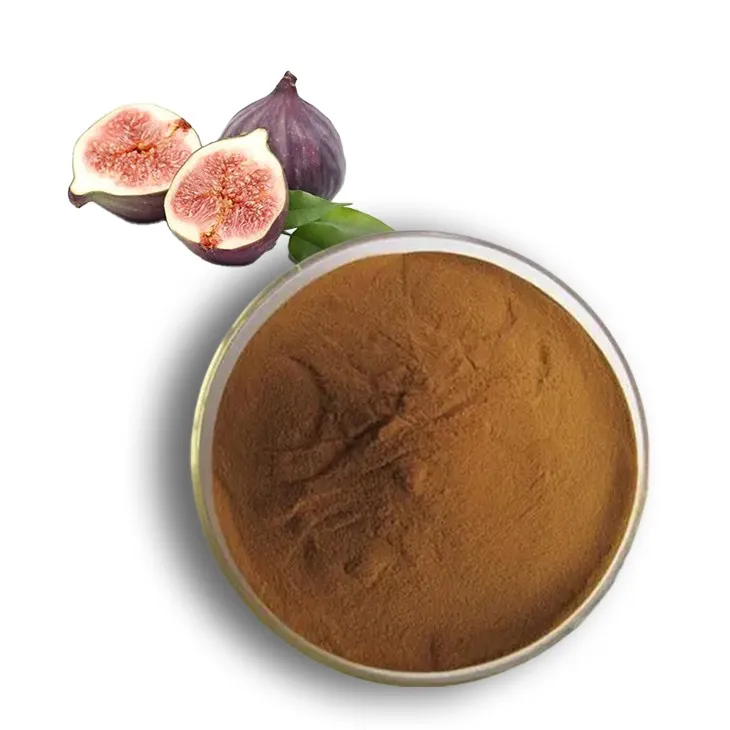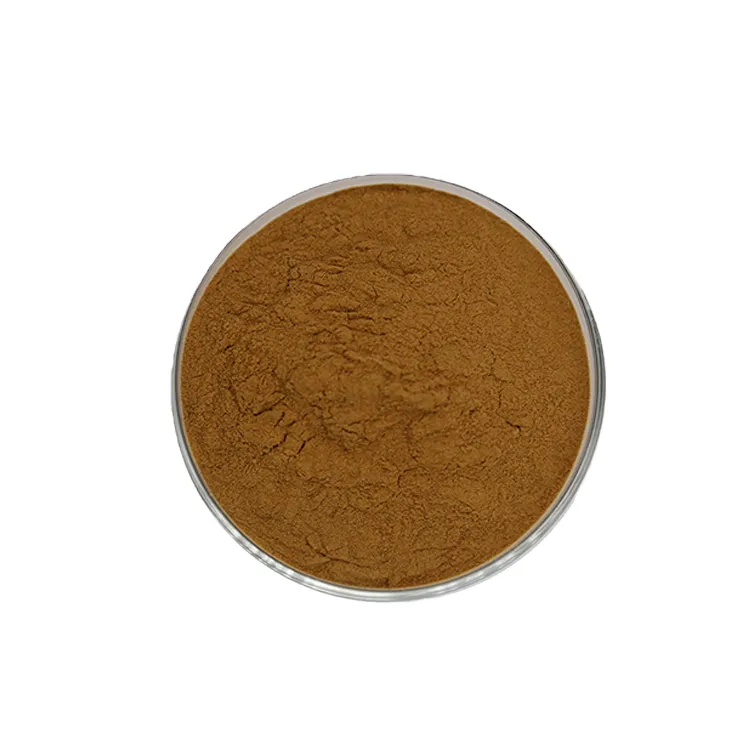- 0086-571-85302990
- sales@greenskybio.com
Extraction Technology and Production Process of Fig Extract.
2024-11-26

1. Introduction
Figs, known for their rich nutritional value and potential health benefits, have been increasingly studied for various applications. The extraction of Fig Extract and its production process play a crucial role in fully exploiting the resources of figs. This article will comprehensively discuss the extraction technology and production process of Fig Extract.

2. Extraction Technology of Fig Extract
2.1 Maceration Extraction
Maceration extraction is a traditional and commonly used method in the extraction of fig extract. In this process, figs are soaked in a suitable solvent. The choice of solvent is vital as it determines the efficiency of extraction and the quality of the final extract. Ethanol is often a popular choice due to its ability to dissolve a wide range of active substances present in figs while being relatively safe and easy to handle.
The figs are typically crushed or cut into smaller pieces before being immersed in the solvent. This increases the surface area in contact with the solvent, facilitating the extraction process. The soaking time can vary depending on various factors such as the type of figs, the desired concentration of the extract, and the nature of the active substances to be extracted. It usually ranges from several hours to several days. During this period, the solvent gradually penetrates the fig tissues, dissolving the active substances such as polyphenols, flavonoids, and vitamins.
2.2 Ultrasonic - Assisted Extraction
Ultrasonic - assisted extraction is a more advanced extraction method in recent years. Ultrasonic waves are applied during the extraction process. These waves create high - frequency vibrations that can effectively break the cell walls of figs. By breaking the cell walls, the active substances that are trapped inside the cells are released more easily and can be dissolved in the solvent more efficiently.
Compared with maceration extraction, ultrasonic - assisted extraction has several advantages. It can significantly reduce the extraction time. For example, while maceration extraction may take days, ultrasonic - assisted extraction can often complete the extraction process within a few hours. Moreover, it can also increase the yield of the active substances. This is because more active substances are released from the cells due to the mechanical effect of ultrasonic waves. Additionally, ultrasonic - assisted extraction may also improve the quality of the extract as it can reduce the degradation of some heat - sensitive active substances that may occur during long - term soaking in maceration extraction.

3. Production Process of Fig Extract
3.1 Cleaning and Pretreatment of Figs
The production process of fig extract starts with the cleaning and pretreatment of figs. Figs are first carefully harvested to ensure their quality. After harvesting, they are thoroughly cleaned to remove dirt, debris, and any pesticides or contaminants that may be present on the surface. This can be achieved through washing with clean water or using mild detergents in some cases, followed by rinsing to ensure no residue is left.
Once cleaned, the figs need to be pretreated. Pretreatment may include steps such as drying, cutting, or crushing. Drying is often necessary if the figs are not to be processed immediately. It helps to preserve the figs and prevent spoilage. When it comes to cutting or crushing, as mentioned before in the extraction technology section, these steps increase the surface area of figs, which is beneficial for the subsequent extraction process.
3.2 Extraction Process
After the cleaning and pretreatment, the figs are ready for extraction. Depending on the chosen extraction method, either maceration extraction or ultrasonic - assisted extraction is carried out. As described earlier, in maceration extraction, the figs are soaked in the solvent for a specific period, while in ultrasonic - assisted extraction, ultrasonic waves are applied during the soaking process. During the extraction, the solvent continuously extracts the active substances from the figs, forming a liquid extract containing various beneficial components.
3.3 Separation and Filtration
Once the extraction is completed, the next step is separation and filtration. The liquid extract needs to be separated from the solid residues of figs. This can be achieved through methods such as filtration or centrifugation. Filtration uses a filter medium, such as filter paper or a filter membrane, to separate the solid particles from the liquid. Centrifugation, on the other hand, uses the principle of centrifugal force to separate the components based on their density differences. After separation and filtration, a relatively pure liquid extract is obtained.
3.4 Concentration
The obtained liquid extract may often have a relatively low concentration of active substances, which may not meet the requirements for some applications. Therefore, concentration is an important step in the production process. Concentration can be carried out through methods such as evaporation under reduced pressure. By reducing the pressure, the solvent can be evaporated at a lower temperature, which helps to preserve the active substances that may be sensitive to high temperatures. As the solvent evaporates, the concentration of the active substances in the remaining liquid increases.
3.5 Drying
Drying is another crucial step in the production process of fig extract. One commonly used drying method is spray drying. In spray drying, the liquid extract is sprayed into a hot drying chamber through a nozzle. As the droplets are exposed to the hot air, the solvent evaporates rapidly, leaving behind solid particles in the form of powder. Spray drying has several advantages. It can quickly convert the liquid extract into a powder form, which is not only convenient for storage but also for further processing and use. The powder form of the fig extract has a relatively large surface area, which may also be beneficial for some applications such as in the formulation of functional foods or dietary supplements.
Other drying methods such as freeze - drying can also be used. Freeze - drying involves freezing the liquid extract first and then removing the water by sublimation under reduced pressure. Freeze - drying can better preserve the structure and activity of the active substances in the extract, but it is generally more expensive and time - consuming compared to spray drying.
3.6 Packaging
After drying, the fig extract in powder form is ready for packaging. Packaging plays an important role in protecting the quality of the fig extract. The packaging materials should be selected based on the characteristics of the extract and the intended storage conditions. For example, if the fig extract is sensitive to light, opaque packaging materials should be used. The packaging should also be airtight to prevent moisture absorption and oxidation, which can degrade the quality of the extract. Proper labeling should be included on the packaging, indicating information such as the name of the product, the composition, the date of production, and the shelf - life.

4. Quality Inspection in the Production Process
Throughout the entire production process of fig extract, quality inspection is carried out to ensure the quality of the final product. Quality inspection includes various aspects.
-
Firstly, the raw materials, i.e., figs, are inspected for their quality. This includes checking for the presence of diseases, pests, and any physical damage. Only high - quality figs should be used for extraction.
-
During the extraction process, the parameters such as the extraction time, temperature, and solvent concentration are monitored. Deviations from the optimal parameters may affect the extraction efficiency and the quality of the extract.
-
After separation and filtration, the purity of the liquid extract is examined. Any remaining solid particles or impurities may indicate an incomplete separation process.
-
For the concentrated extract, the concentration level of the active substances is measured to ensure that it meets the required standards.
-
In the drying process, the moisture content of the dried product is determined. Excessive moisture can lead to spoilage and affect the stability of the extract.
-
Finally, the packaged fig extract is also inspected for its appearance, packaging integrity, and label accuracy.
5. Conclusion
In conclusion, the extraction technology and production process of fig extract are complex and multi - step procedures. The extraction technology, including maceration extraction and ultrasonic - assisted extraction, each has its own characteristics and advantages. The production process from the initial cleaning and pretreatment of figs to the final packaging involves multiple important steps such as extraction, separation, concentration, drying, etc. Strict quality inspection during the whole process is essential to ensure the high quality of the fig extract. With the continuous development of technology and research, it is expected that more efficient extraction methods and more optimized production processes will be developed in the future, which will further promote the utilization of fig resources in various fields.
FAQ:
What are the common extraction methods for fig extract?
Two common extraction methods for fig extract are maceration extraction and ultrasonic - assisted extraction. In maceration extraction, figs are soaked in a suitable solvent for a while. Ultrasonic - assisted extraction uses ultrasonic waves to break the cell walls of figs more effectively, facilitating the release of active substances.
Why is ultrasonic - assisted extraction effective for fig extract?
Ultrasonic - assisted extraction is effective for fig extract because ultrasonic waves can break the cell walls of figs more efficiently. By doing so, it promotes the release of active substances within the figs, which is beneficial for the extraction process.
What are the important steps in the production process of fig extract?
The production process of fig extract includes several important steps. It starts with the cleaning and pretreatment of figs. Then comes the extraction process using methods like maceration or ultrasonic - assisted extraction. After that, the drying process, such as spray drying which can quickly turn the liquid extract into powder form for easy storage and further use. And strict quality inspection throughout the whole process is also crucial to ensure the quality of the fig extract.
How does spray drying affect the quality of fig extract?
Spray drying can quickly convert the liquid fig extract into powder form. This not only makes it convenient for storage but also has an impact on its quality. It helps to preserve the active substances in the extract and can maintain the overall quality characteristics, making it more suitable for further use.
Why is quality inspection necessary during the production of fig extract?
Quality inspection is necessary during the production of fig extract because it ensures the quality of the final product. It helps to identify any potential issues or contaminants at each stage of the production process, from the raw materials (figs) to the final packaged extract, so that only high - quality fig extract is produced.
Related literature
- Optimization of Extraction Technology for Fig Active Components"
- "Fig Extract: Production and Quality Control"
- "Advanced Extraction and Production Processes of Fig Extract"
- ▶ Hesperidin
- ▶ citrus bioflavonoids
- ▶ plant extract
- ▶ lycopene
- ▶ Diosmin
- ▶ Grape seed extract
- ▶ Sea buckthorn Juice Powder
- ▶ Beetroot powder
- ▶ Hops Extract
- ▶ Artichoke Extract
- ▶ Reishi mushroom extract
- ▶ Astaxanthin
- ▶ Green Tea Extract
- ▶ Curcumin Extract
- ▶ Horse Chestnut Extract
- ▶ Other Problems
- ▶ Boswellia Serrata Extract
- ▶ Resveratrol Extract
- ▶ Marigold Extract
- ▶ Grape Leaf Extract
- ▶ blog3
- ▶ blog4
-
Chinese Withania somnifera Extract Factory.
2024-11-26
-
中国松树皮提取物粉粉末供应商
2024-11-26
-
High - quality Marigold Extract Products.
2024-11-26
-
100% Pure Natural Mango - Flavored Powder.
2024-11-26
-
Almond Extract Powder
2024-11-26
-
Sea buckthorn oil
2024-11-26
-
Europen Bilberry Extract
2024-11-26
-
Carrageenan Extract Powder
2024-11-26
-
Red Wine Extract
2024-11-26
-
Purple Sweet Potato Extract
2024-11-26
-
Withania Somnifera Extract
2024-11-26
-
Avocado Extract Powder
2024-11-26
-
American Ginseng Root Extract
2024-11-26
-
Calendula Extract
2024-11-26





















